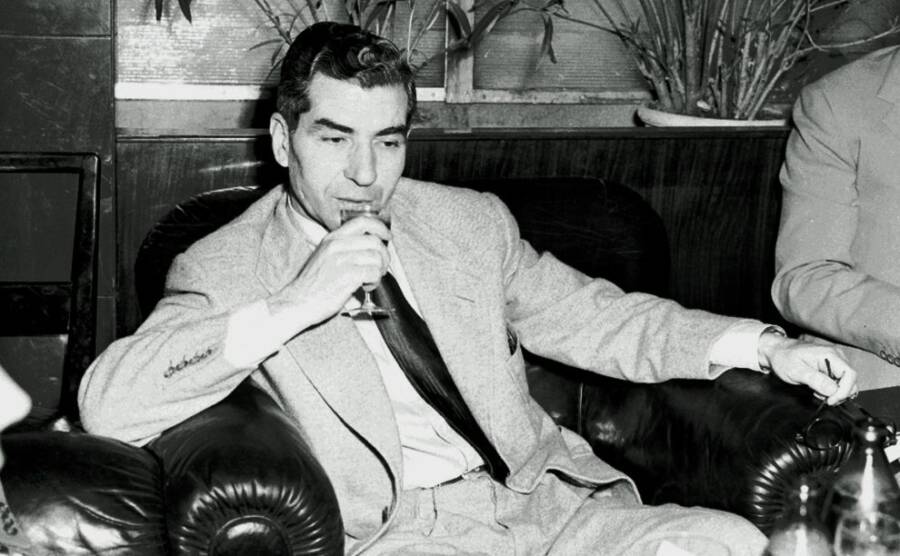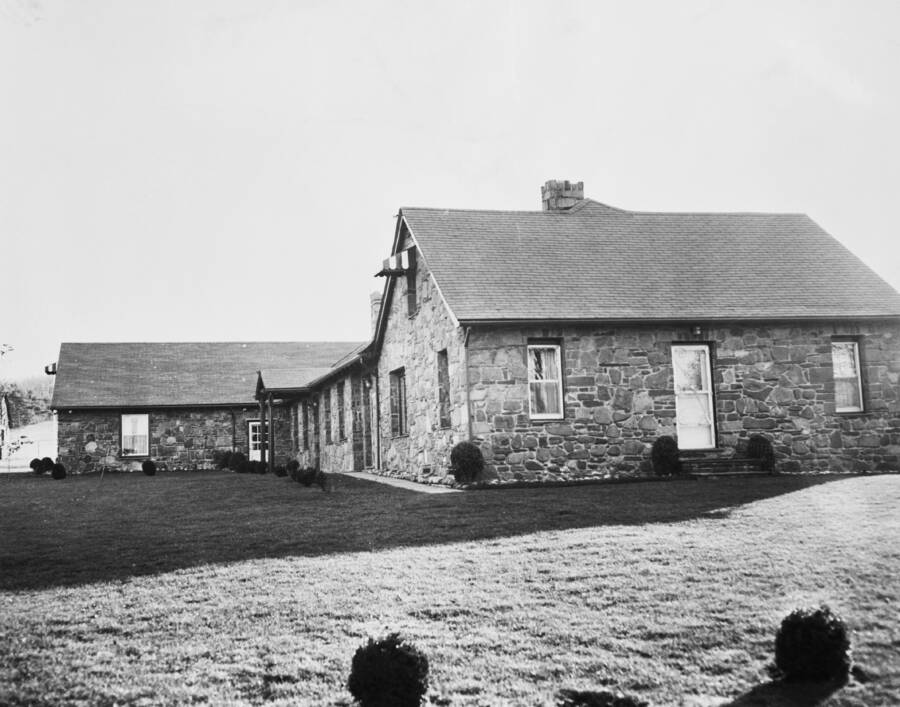The 1957 Apalachin meeting held in upstate New York was meant to solidify and streamline underground operations. Instead, it was raided by police and brought the Mafia down.

Library of CongressVito Genovese, whose 1957 Apalachin meeting heralded the end of the Mafia’s invulnerability.
In 1957, newly-ascendant mob boss Vito Genovese felt on top of the world, and he wanted other mafia leaders to recognize it. So he called what is now referred to as the Apalachin meeting.
After years of quiet but violent power struggles for control of the Luciano crime family following Charles “Lucky” Luciano’s exile to Italy, Genovese’s two main rivals, Frank Costello and Albert Anastasia, were dead on his orders.
But both Anastasia and Costello were both survived by powerful friends who could sour Genovese’s victory with an all-out war. To avert a bloodbath, Genovese turned to the mob confederacy known as the Commission, summoning more than 100 of the most powerful gangsters in the country to sleepy Apalachin, New York.
The summit was meant to seal Genovese’s rise to the top. No one could have known at the time that it would be the high-water mark of the American Mafia and the beginning of its downfall.
Vito Genovese’s War For Power

Wikimedia CommonsCharles “Lucky” Luciano, the Italian-born gangster who laid the foundation for the American Mafia.
Upon arriving in the United States in 1913 from his small hometown in Naples, Italy, Genovese had begun carving a bloody path to power in New York’s criminal underworld, beginning as a runner for Giuseppe “Joe the Boss” Masseria, mentor of Lucky Luciano and the undisputed ruler of Italian Harlem.
Over the following decades, he built an impressive rap sheet for himself, including numerous counts of theft, racketeering, and no less than five counts of murder. Somehow, the witnesses in each murder trial had a way of disappearing, leaving Genovese free to walk each time.
After one of these murders, that of gangster Ferdinand Boccia, Genovese fled New York for his homeland, where he spent the next ten years cozying up to dictator Benito Mussolini and laying the groundwork for the heroin pipeline later infamously known as “the French Connection.”
By the time he returned to New York in 1946 after a failed extradition attempt, he was no longer the top earner he’d once been.
Albert Anastasia now ruled the Brooklyn docks, and therefore the booming trade in smuggled narcotics. And Anastasia let Genovese know it with classic Mafia understatement.
“I’m not saying I disagree with you,” Anastasia told Genovese over a matter of opinion at Vito’s welcome-home banquet, “but I’m not saying I agree with you, either.”
Vito Genovese saw that he’d have to fight his way back to the top, and his first obstacle was the only man who had declined to agree with him.
Summoning The Mob To The Apalachin Meeting

Getty ImagesAfter a long and lucrative career in organized crime, Joseph “Joe the Barber” Barbara relocated to a country estate in Apalachin, New York, where he presented himself as a legitimate businessman.
Luciano was extradited to Italy in 1946 as a reward for his wartime assistance in suppressing labor organizers on the New York waterfront. This left his family in the care of underboss Frank Costello.
Although Costello was initially untouchable, his power eroded throughout the ’50s as his muscle and his trusted lieutenants either died or were deported.
By 1956, a decade after Luciano was extradited and Genovese returned to the U.S., Costello’s sole remaining ally was Albert Anastasia. All the while, Genovese had slowly built friendships and gathered strength, waiting for his chance.
That chance came on May 2, 1957. As Costello returned home that evening, an assassination attempt startled him into retiring. Next, on October 25, two of Genovese’s hitmen shot Anastasia in the barbershop of Manhattan’s Park Sheraton Hotel.
Genovese had seized control of the Luciano family, now called the Genovese family. But, like all powerful groups, he needed the approval of his fellow bosses to hold onto it. And that meant calling a summit attended by the Commission, the inter-family group established after the violence of Prohibition to keep the peace.
The site chosen was the rural estate of his friend, Joseph “Joe the Barber” Barbara, in Apalachin, New York, 200 miles northwest of New York City and the prying eyes of police.
In response to the summons, bosses and top figures from each of New York’s Five Families and Mafia clans from as far away as California, Florida, and Cuba barreled down the highways to rural New York in sleek, brand-new Cadillacs.
Individually, these cars might have slipped by unnoticed. But when local New York State Police detective Ed Croswell saw dozens of gleaming Cadillacs parked next to the only paved stretch of the back road leading to Barbara’s house on November 14, 1957, he knew something was up.
How A Suspicious Cop Discovered The Apalachin Meeting

Getty ImagesSergeant Edgar D. Croswell, whose suspicions were aroused at the sight of dozens of shiny new Cadillacs on a quiet country road.
For a cop far from coastal Mafia hotspots, Croswell was surprisingly familiar with their activities. Kingpins had been moving out of the city throughout the 1950s in a reflection of the suburban shift throughout the country.
Croswell had even arrested a Genovese hitman in the 1940s, and he’d kept a close eye on Joe Barbara, the supposedly legitimate businessman dwelling in the rambling fieldstone manor above downtown Apalachin.
Along with his partner and two federal agents, Croswell made his way up to the house and noted the license plates. He saw that they originated in half a dozen states other than New York. And he noted a crowd of what he called “fourteen-carat hoodlums.”
That observation coupled with the fact that Croswell had intelligence that Barbara had ordered 200 pounds of meat suggested a party. He called for backup, blocked off all four nearby roads, and waited.
When Josephine Barbara spotted the police as the assembled crowd began a gargantuan cookout, all 100 gangsters fled, some to their cars, others into the woods, despite wearing a fortune between them in gold, diamonds, and tailored suits, and with pockets crammed with thousands in cash.
Locals claimed that even months later, they were still picking hundred-dollar bills out of the leaves in the woods around the house.
The police managed to detain and questioned dozens of mobsters, including Genovese, who claimed to have been visiting his friend Barbara due to an alleged illness. More than 60 people were arrested in the woods and roads around the Barbara estate, though, somehow, Genovese was let go.
The Apalachin Meeting Leads To The Mob’s Downfall

Library of CongressSenator John L. McClellan and Robert F. Kennedy (right) hearing testimony before the Senate Rackets Committee.
Among the 62 arrested, 20 Apalachin attendees were initially “convicted of conspiring to commit perjury and obstruct justice.” Croswell doubted whether such bulletproof men as those arrested at Apalachin had much to worry about in court, but he said that at least “the New York State Police action threw the mobsters up in the air, where everyone could take a shot at them.”
Sure enough, all convictions were overturned the following year, but the damage was done.
Although he wasn’t among those arrested that day, the Apalachin meeting couldn’t have been more of a disaster for Vito Genovese. At what was supposed to be his coronation, he’d inadvertently drawn more publicity than any criminal could want, exposing his fellow mobsters to public and legal scrutiny.
It was also a national embarrassment for long-time FBI director J. Edgar Hoover, who had insisted for decades that there was no such thing as a national Mafia, and therefore nothing for him to investigate. The vaunted chief cop of the United States had been shown up by a humble cop from Upstate New York.
The press had a field day. And so did Robert F. Kennedy, who was then serving as counsel to the Senate Select Committee on Improper Activities in Labor and Management, also known as the “Rackets Committee.” As such, Kennedy kept a watchful eye on mob-related labor racketeering.
Kennedy wound the Apalachin meeting into his ongoing anti-mob campaign as evidence of a national conspiracy. Through hundreds of hours of testimony before the committee — and Kennedy’s relentlessly tough questioning — the extent of corruption under organized crime was laid bare.
In fact, Robert Kennedy was so sure of the damage he’d done to organized crime in the United States that years later he was equally certain that his brother’s 1963 assassination was revenge for his crusade against it.
The End Of The Mafia’s Golden Age

Getty ImagesNew York State Police Sergeant Ed Croswell’s quick thinking led to the arrest of dozens of top-ranking mafiosi.
Vito Genovese didn’t reign for long. Equally hated by the Mafia for what they saw as his responsibility in exposing them and by the public for his decades of violent activity, no one was sad to see him go when he was convicted on narcotics charges in April, 1959, and sentenced to 15 years in federal prison.
Genovese’s enforcer Joseph Valachi was also convicted that month. And in 1963, Valachi testified against his boss, after he claimed that the suspicious Genovese had given him “the kiss of death,” marking him out for assassination.
Between public infamy, official embarrassment, and Valachi’s damning testimony, Genovese was cut off from the outside world forever. He died in a federal prison hospital in Springfield, Missouri on February 14, 1969.
Before his death, he would remark that he wished he’d “broken both my legs before I accepted that invitation [to the Apalachin meeting].”
Before the Apalachin meeting, the Mafia was a boogeyman known only in the movies and to an unfortunate few who had direct dealings with them.
After the meeting, the federal government was forced to crack down on the Mafia. The glory days were over, and an arsenal of anti-mob laws were passed to enable the FBI and other agencies to drive what Valachi called “la Cosa Nostra” back into obscurity.
After learning how the Mafia was undone at Apalachin, find out more about how they rose to power in the aftermath of the bloody Mafia-Camorra War. Then, read about the death of Joe Masseria, the original kingpin whose lieutenants built the American Mafia.





